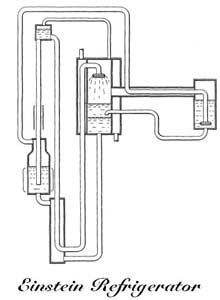An early invention by Albert Einstein has been rebuilt by scientists at Oxford University who are trying to develop an environmentally friendly refrigerator that runs without electricity.
Modern fridges are notoriously damaging to the environment. They work by compressing and expanding man-made greenhouse gases called freons - far more damaging that carbon dioxide - and are being manufactured in increasing numbers. Sales of fridges around the world are rising as demand increases in developing countries.
Now Malcolm McCulloch, an electrical engineer at Oxford who works on green technologies, is leading a three-year project to develop more robust appliances that can be used in places without electricity.

His team has completed a prototype of a type of fridge patented in 1930 by Einstein and his colleague, the Hungarian physicist Leo Szilard. It had no moving parts and used only pressurised gases to keep things cold. The design was partly used in the first domestic refrigerators, but the technology was abandoned when more efficient compressors became popular in the 1950s. That meant a switch to using freons.
Einstein and Szilard's idea avoids the need for freons. It uses ammonia, butane and water and takes advantage of the fact that liquids boil at lower temperatures when the air pressure around them is lower. 'If you go to the top of Mount Everest, water boils at a much lower temperature than it does when you're at sea level and that's because the pressure is much lower up there,' said McCulloch.
At one side is the evaporator, a flask that contains butane. 'If you introduce a new vapour above the butane, the liquid boiling temperature decreases and, as it boils off, it takes energy from the surroundings to do so,' says McCulloch. 'That's what makes it cold.'
Pressurised gas fridges based around Einstein's design were replaced by freon-compressor fridges partly because Einstein and Szilard's design was not very efficient. But McCulloch thinks that by tweaking the design and replacing the types of gases used it will be possible to quadruple the efficiency. He also wants to take the idea further. The only energy input needed into the fridge is to heat a pump, and McCulloch has been working on powering this with solar energy.
'No moving parts is a real benefit because it can carry on going without maintenance. This could have real applications in rural areas,' he said.
McCulloch's is not the only technology to improve the environmental credentials of fridges. Engineers working at a Cambridge-based start-up company, Camfridge, are using magnetic fields to cool things. 'Our fridge works, from a conceptual point of view, in a similar way [to gas compressor fridges] but instead of using a gas we use a magnetic field and a special metal alloy,' said managing director Neil Wilson.
'When the magnetic field is next to the alloy, it's like compressing the gas, and when the magnetic field leaves, it's like expanding the gas.' He added: 'This effect can be seen in rubber bands - when you stretch the band it gets hot, and when you let the band contract it gets cold.'
Doug Parr, chief scientist at Greenpeace UK, said creating greener fridges was hugely important. 'If you look at developing countries, if they're aspiring to the lifestyles that we lead, they're going to require more cooling - whether that's air conditioning, food cooling or freezing. Putting in place the technologies that are both low greenhouse-gas refrigerants and low energy use is critical.'
McCulloch's fridge is still in its early stages. 'It's very much a prototype; this is nowhere near commercialised,' he said. 'Give us another month and we'll have it working.'



No comments:
Post a Comment